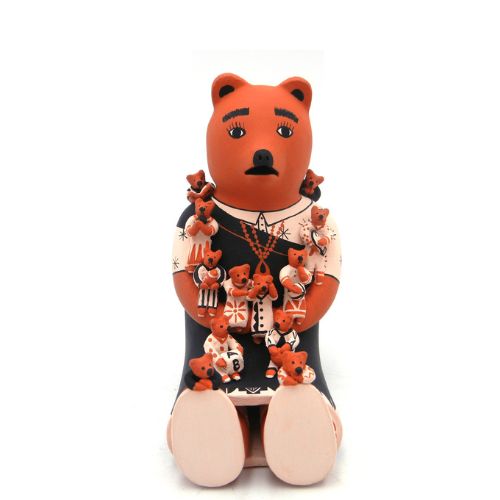Pueblo pottery is a revered art form with a deep-rooted history for the Native American tribes of New Mexico. It’s an integral part of their culture and legacy.
The Cochiti tribe is known for its exceptional pottery skills and its unique tradition of storyteller figurines. Through these intricately crafted clay creations, the Cochiti people skillfully weave stories to transmit their ancestral narratives to future generations.
At Palms Trading Company, we sell authentic Pueblo pottery that reflects the rich cultural heritage of Native American tribes. Let’s explore the fascinating world of storytellers and their significance.
Facts About the Cochiti Tribe
The Cochiti tribe is an indigenous Pueblo tribe located southwest of Santa Fe, New Mexico. Though this tribe is where the storyteller figurine originated, they are also known for several other noteworthy reasons.
The Remarkable Keresan Language
Of the 4 primary language families spoken by Pueblo Indians–Keresan, Tanoan, Hopi, and Zunian–the Cochiti speak Keresan.
Keresan is a language isolate, meaning it has no genetic relationship to any other language. It’s a language unique only to the Keres Pueblo Native Americans of New Mexico and is not a written language.
These facts mean that if the Keresan language were to disappear in New Mexico, we would lose access to it entirely, along with the history it carries. This is why oral traditions are paramount to the Cochiti people. They serve as a way to pass down the language and culture to future generations.
Oral storytelling was an essential part of daily life for the Cochiti and was often a formal event.
Storytelling typically involved the tribe gathering around an elder. That elder would then tell a meaningful story about the past or give wise advice to the young. This tradition ensured that these stories would be preserved and shared for generations.
After the event, storyteller figurines were made as a physical representation of the story that was told. In this way, storytellers replaced writing as a means of recording history, and the indigenous people had an extraordinary history to tell!
The Pueblo Revolt of 1680
In the past, the Spanish had placed strict regulations on these figurative Pueblo pottery objects because they were seen as idol worship.
This led to the Cochiti tribe actively taking part in the Pueblo Revolt of 1680, which was a protest against the religious, economic, and political rules imposed on the indigenous people.
During this time, Native American tribes fought back by creating figurative pottery as social commentary that mocked the Spanish and empowered the native people.
They tried to restore old customs and banish Spanish culture before launching a full-scale rebellion in which nearly all Pueblo tribes took part. This revolt managed to overthrow Spanish rule in New Mexico for 12 years until the Spanish reconquered the area in 1692.
However, the storyteller’s rich history of rebellion and their powerful message is why the Cochiti tribe’s Pueblo pottery traditions are still thriving today.
Several other tribes have also adopted this tradition. Isleta artists have created an abundance of storytellers in New Mexico, and Jemez storytellers are the most prominent in the market today.
Let’s take a look at what a traditional storyteller figurine entails.
The Making of the Pueblo Storyteller Figurine
Storyteller figurines are handcrafted with precision and attention to detail. Traditionally made from local clay, the figures are skillfully molded, smoothed, and painted using natural pigments.
Each storyteller portrays an elder, often with a distinctive facial expression and traditional attire. Children surround the seated elder. This scene symbolizes the passing down of wisdom, knowledge, and cultural heritage from one generation to the next.
Expressions, gestures, and postures are a vital part of all storytellers. It’s how artists convey excitement and wonder in the stories being told. The children depicted in the figurines symbolize the listeners eagerly engaged in absorbing the wisdom and tales shared by the elder.
Each figurine is a visual narrative, with the storyteller’s facial expressions and gestures adding depth and emotion to the scene. When buying a storyteller, striking expressions and refined artistry are what to look for.
4 Reasons Why You Should Consider Purchasing a Storyteller
Storytellers are more than just an art piece. They are representations of many different significant ideas.
Below are 4 reasons why storytellers would make an excellent addition to your home.
1. Embraces Cultural Heritage
Pueblo pottery storytellers are not just exquisite pieces of art but also tangible connections to the rich cultural heritage of the Cochiti, Jemez, and Isleta tribes. By purchasing a storyteller, you’re fostering an appreciation for indigenous culture and keeping their traditions alive.
2. Cultivates Unique Artistic Expression
Each Pueblo storyteller is uniquely crafted with meticulous care and artistic skill. These clay figurines showcase the talent and creativity of Native American potters, making them exceptional and distinct art pieces to add to your collection.
3. Preserves Symbolism and Meaning
Pueblo storytellers carry profound symbolism and meaning. As you display these figurines in your home, they remind you of the power of storytelling.
They embody wisdom, unity, and the passing down of ancestral knowledge. If you connect with any of these values, consider buying a storyteller. A storyteller physically represents those meanings and can add a special touch to your home.
4. Supports Indigenous Artists
Purchasing a Pueblo pottery storyteller directly supports indigenous artists in the Cochiti, Jemez, and Isleta communities. Your investment contributes to the continuation of traditional craftsmanship. Any purchase helps sustain the cultural legacy of these tribes for future generations, meaning you can feel good about owning a storyteller.
Where to Discover Authentic Pueblo Pottery Storytellers
Here at Palms Trading Company, we buy our storytellers directly from Pueblo artists so that you can guarantee you’re supporting indigenous artists and that your product is authentic. Storytellers are cultural relics from the Cochiti, Jemez, and Isleta tribes. They are beautiful clay creations that would enliven any art collection.
Contact us today to see our selection of unique Pueblo pottery storytellers!



